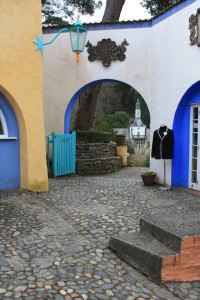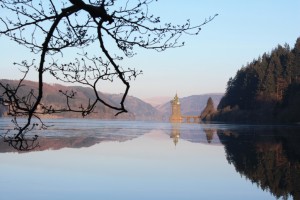It’s been over 700 years since King Edward I of England, aka “Longshanks,” defeated Llywelyn ap Gruffudd, the last true Prince of Wales, and built an iron ring of castles along the coast at strategic locations like Caernarfon, Conwy and Harlech — today, world heritage sites — to dissuade further rebellion. But the Welsh remain as stubbornly independent as old cats.
Even today, the population that speaks in the throaty tones of the Welsh language as fluently as English stands at 22% and growing. The Welsh are as vehemently proud of their Brain’s brand beer as they are of their national rugby club and all things uniquely Welsh, like a new sport called bogsnorkelling — the name pretty much describes it.
But there is nothing more precisely Welsh than their eclectic collection of eccentric resorts. It seems odd to think of resorts in the land that mined so much slate it was once known as the country that roofed the world. Hills of slag left over from the coal mining era blend into the rolling countryside north of Cardiff.
One coal baron known for his derisive attitude toward his workers built a stone mansion on a hill so he could literally look down on them. He left strict instructions that after his death he’d be buried beneath an enormous stone slab for fear his body would be dug up and desecrated. His headstone reads simply, “May God Forgive Me.”
The slate and coal mines made for immense wealth. The barons built themselves castles for homes, but they also built and frequented resorts that are today accessible by a much wider public than in the past.
Llandudno, Queen of the Welsh Resorts
Approaching the resort town of Llandudno at sunset is like driving into a children’s pop-up book. The sun sinks into the warm waters of the Gulf Stream that flow along this northern coast to temper the climate, its watercolor wash of sky book-ended by two rocky outcrops — the Great Orme and the Little Orme — at either end of a sweeping crescent of beach. The Great Orme to the west dwarfs a long Victorian pier. A wide promenade runs parallel to the beach and beside it a road, across which stands a row of carefully constructed hotels, all roughly the same height and painted the same pastel variations of white.
When Lord Mostyn built Llandudno into a resort town in the mid 1800s, they set out strict zoning regulations that prohibited any building but a hotel on the street facing the beach, so it’s a surprise to wander down a side street and come upon a thriving town of shops, restaurants, malls and gas stations.
The St. Georges was the first hotel built on the promenade in 1854. It offers elegance, Welsh style. Down creaky hallways, the rooms feel modern, but offer views (doubling as time travel into another age) across the promenade to the pier where the Punch and Judy puppet shows originated. The menu at the restaurant is very much a part of the Welsh culinary revival. The braised shoulder and canon of lamb with parsnip puree and confit of onions and thyme sauce is a contemporary take on traditional ingredients and a perfect end to the day.
Portmeirion
If Dr. Seuss had been a Welsh architect, he might have built a resort like Portmeirion. Over the mountains of Snowdonia National Park from Llandudno, Portmeirion is nestled like a jewel in a cove along the northwest coast. The self-contained village — with its whimsical buildings painted hydrangea blue and lemon custard yellow, gardens, grottos and sculptures — is truly a retreat from the world. Strolling the grounds, one can’t help but smile at the joy of life expressed in the design of the place. It’s easy to see how Noël Coward could write Blithe Spirit here in five days.
Architect Clough Williams-Ellis was the Welsh Dr. Seuss who purchased the 170-acre estate in 1925. He described it as “a neglected wilderness long abandoned by those romantics who had realized the unique appeal and possibilities of this favoured promontory but who had been carried away by their grandiose landscaping… into sorrowful bankruptcy.”
Thus, Clough discovered the site for the utopian coastal village he’d been planning and sketching for some time. Today, a private foundation owns the village that Clough took 50 years to build, at times barely escaping bankruptcy himself.
True to Clough’s motto of “Cherish the past, adorn the present, construct the future,” Robin Llywelyn — Clough’s grandson and the current Managing Director — operates the hotel, restaurants, shops and the 17 self-catering villas and cottages (₤672 – 1799 per week) in a spirit that celebrates human creativity.
“It has no purpose as such,” says Llywelyn of his grandfather’s creation, “no raison d’etre except that it is itself.” It just feels good to be alive and human in Portmeirion.
Lake Vyrnwy
On a crisp March morning, I stand on the shore of Lake Vyrnwy, mid-Wales, the sunrise splitting the wooded hills that cradle the lake’s Victorian stone dam. Otherwise, the only structure in sight is the iconic 60 ft Gothic tower rising from the lake as if a castle lies just beneath the water’s surface. There is no wind. Birds sing forth the spring.
As I look on, the sun catches the tip of the tower’s copper roof… and suddenly a human voice sings over the birds. A shepherd calls in song to his flock from a pasture beyond the trees.
The sheep answer.
The shepherd’s song alone is enough to transport me from a world of worries, but there’s so much more.
Back at the newly renovated Lake Vyrnwy Hotel, a resort built in the 1890s from leftover materials from the construction of the dam (next to the Panama Canal, the largest civil construction project of it’s time), I warm myself at the fireplace, review today’s menu — I have my eye on the pheasant and leeks in white wine sauce with Welsh honey — and contemplate a morning at the spa.
“Around here, it’s been slow food forever,” says General Manager Anthony Rosser who supervised the addition of 14 rooms in 2007 and helped the resort qualify for 4-star status in 2009.
He tells me WWII fighter aces recuperated here, so it’s not hard to believe this resort — equipped with a Scandinavian sauna, experience showers, heated tepidarium seats, salt steam and ice fountain — also offers brown and rainbow trout fishing as well as pheasant hunting. Shooting season opens every year in August on “the glorious 12th.”
Leaving the Welsh resort circuit, I feel rested and even pampered. But more remarkably, I feel something akin to homesick for a land, a people, their human joy and their national pride in everything from lakes to leeks. “Hwyl,” til next time.
Photo Credits
“Llandudno is known as the Queen of Welsh resorts” © Darcy Rhyno
“A detail from a courtyard in the resort town of Portmeirion, Wales” © Darcy Rhyno
“Tucked in the hills of central Wales, Lake Vyrnwy offers fishing, pheasant shooting and a spa” © Darcy Rhyno





Don’t forget the strange place that Portmeirion holds in pop culture – the resort was the set of the British sci-fi series The Prisoner in the 1960s.